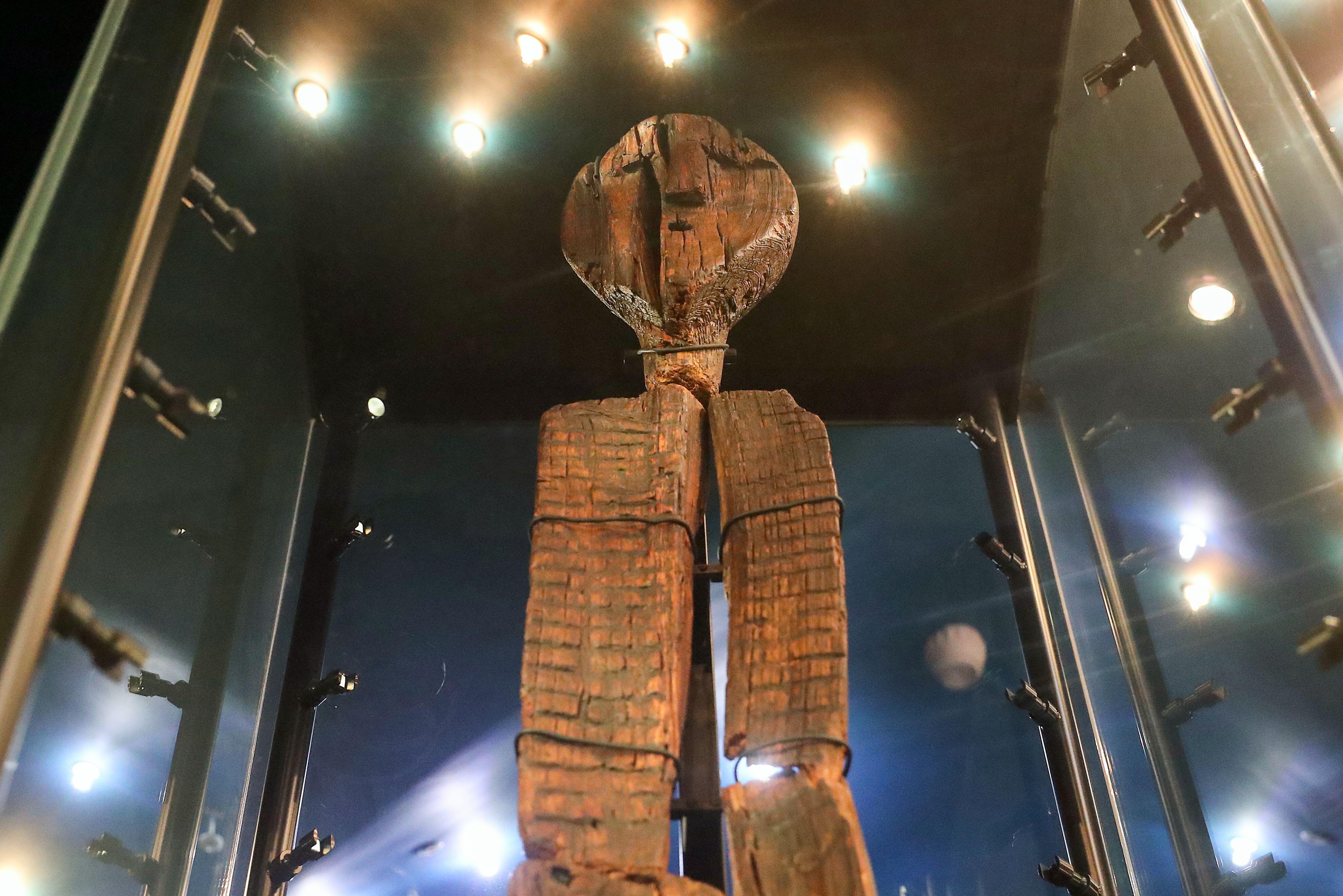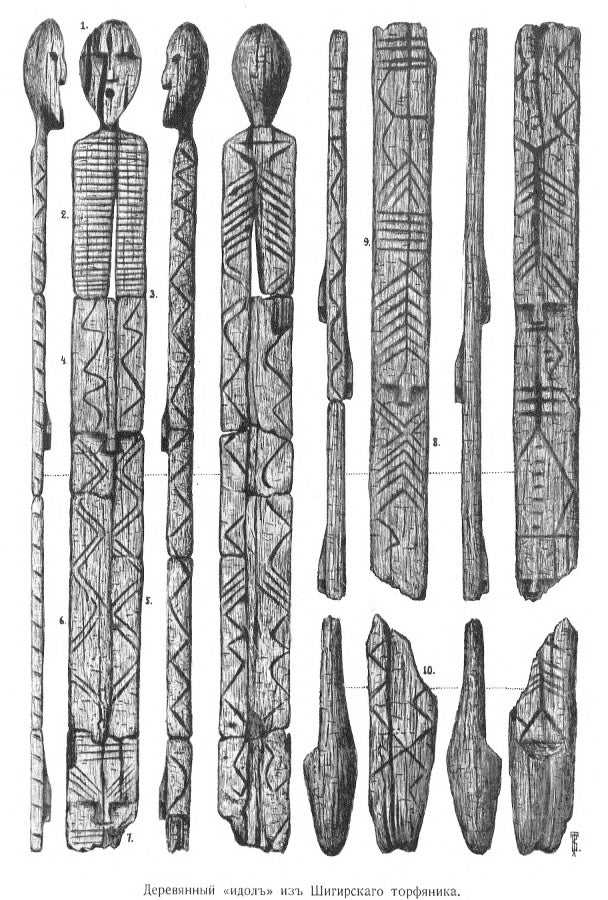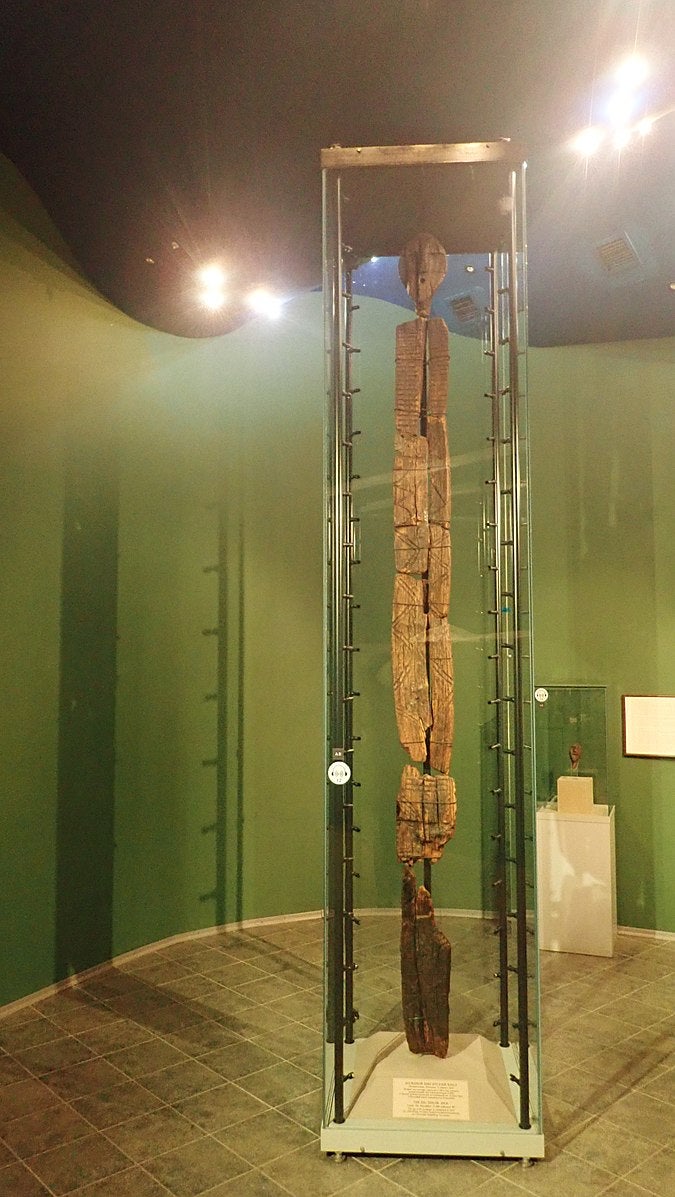The world’s oldest wooden sculpture is reshaping prehistory
A study dates Russia’s Shigir Idol 900 years earlier than believed, making it over 10,000 years old and the only Stone Age wooden carving still in existence, writes Franz Lidz

Your support helps us to tell the story
From reproductive rights to climate change to Big Tech, The Independent is on the ground when the story is developing. Whether it's investigating the financials of Elon Musk's pro-Trump PAC or producing our latest documentary, 'The A Word', which shines a light on the American women fighting for reproductive rights, we know how important it is to parse out the facts from the messaging.
At such a critical moment in US history, we need reporters on the ground. Your donation allows us to keep sending journalists to speak to both sides of the story.
The Independent is trusted by Americans across the entire political spectrum. And unlike many other quality news outlets, we choose not to lock Americans out of our reporting and analysis with paywalls. We believe quality journalism should be available to everyone, paid for by those who can afford it.
Your support makes all the difference.The oldest-known wooden sculpture – a 9ft totem pole thousands of years old – looms over a hushed chamber of an obscure museum in the Ural Mountains, not far from the Siberian border.
As mysterious as are the huge stone figures of Easter Island, the Shigir Idol, as it is called, is a landscape of uneasy spirits that baffles the modern onlooker.
Dug out of a peat bog by gold miners in 1890, the relic, or what’s left of it, is carved from a great slab of freshly cut larch. Scattered among the geometric patterns (zigzags, chevrons, herringbones) are eight human faces, each with slashes for eyes that peer not so benignly from the front and back planes.
The top-most mouth, set in a head shaped like an inverted teardrop, is wide open and slightly unnerving. “The face at the very top is not a passive one,” says Thomas Terberger, an archaeologist and head of research at the Department of Cultural Heritage of Lower Saxony, Germany. “Whether it screams or shouts or sings, it projects authority, possibly malevolent authority. It’s not immediately a friend of yours, much less an ancient friend of yours.”
Read More:
In archaeology, portable prehistoric sculpture is called “mobiliary art”.
With the miraculous exception of the Shigir Idol, no Stone Age wood carvings survive. The statue’s age was a matter of conjecture until 1997, when it was carbon-dated by Russian scientists to about 9,500 years old, an age that struck most scholars as fanciful. Sceptics argued that the statue’s complex iconography was beyond the reach of the hunter-gatherer societies at the time; unlike contemporaneous works from Europe and Asia featuring straightforward depictions of animals and hunt scenes, the Shigir Idol is decorated with symbols and abstractions.
In 2014, Terberger and a team of German and Russian scientists tested samples from the idol’s core – uncontaminated by previous efforts to conserve the wood – using accelerator mass spectrometry. The more-advanced technology yielded a remarkably early origin: roughly 11,600 years ago, a time when Eurasia was still coming out of the last Ice Age. The statue was more than twice as old as the Egyptian pyramids and Stonehenge, as well as, by many millennia, the first known work of ritual art.
A study that Terberger wrote with colleagues in Quaternary International, further modifies our understanding of prehistory by moving the date of the Shigir Idol 900 years earlier, placing it in the context of the early art in Eurasia.
“The idol was carved during an era of great climate change, when early forests were spreading across a warmer late-glacial to postglacial Eurasia,” Terberger says. “The landscape changed, and the art – figurative designs and naturalistic animals painted in caves and carved in rock – did, too, perhaps as a way to help people come to grips with the challenging environments they encountered.”
It’s similar to the ‘Neanderthals did not make art’ fable, which was entirely based on absence of evidence
Written with an eye towards disentangling Western science from colonialism, Terberger’s latest paper challenges the ethnocentric notion that pretty much everything, including symbolic expression and philosophical perceptions of the world, came to Europe by way of the sedentary farming communities in the Fertile Crescent 8,000 years ago.
“Ever since the Victorian era, Western science has been a story of superior European knowledge and the cognitively and behaviourally inferior ‘other’,” Terberger says. “The hunter-gatherers are regarded as inferior to early agrarian communities emerging at that time in the Levant. At the same time, the archaeological evidence from the Urals and Siberia was underestimated and neglected. For many of my colleagues, the Urals were a very terra incognita [unknown land].”
To João Zilhão, a paleoanthropologist at the University of Barcelona who was not involved in the study, the message of the research is that absence of evidence is not evidence of absence.
“It’s similar to the ‘Neanderthals did not make art’ fable, which was entirely based on absence of evidence,” he says. “And then the evidence was found and the fable exposed for what it was. Likewise, the overwhelming scientific consensus used to hold that modern humans were superior in key ways, including their ability to innovate, communicate and adapt to different environments. Nonsense, all of it.”
Zilhão says the Shigir Idol findings revealed the extent to which preservation biases affect our understanding of Paleolithic art. “Most of the art must have been made of wood and other perishables,” he says. “Which makes it clear that arguments about the wealth of mobiliary art in, say, the Upper Paleolithic [Late Stone Age] of Germany or France by comparison with southern Europe, are largely nonsensical and an artifact of tundra (where there are no trees and you use ivory, which is archaeologically visible) versus open forest environments (where you’d use wood, which is archaeologically invisible).”

Olaf Jöris, of the Leibniz Research Institute for Archaeology, agrees. “The new Shigir evidence makes archaeologists daydream of how the archaeological record may have looked if wooden remains had been preserved in greater abundance,” he says.
The Shigir Idol, named for the bog near Kirovgrad in which it was found, is presumed to have rested on a rock base for perhaps two or three decades before toppling into a long-gone paleo-lake, where the peat’s antimicrobial properties protected it like a time capsule. In the mid-19th century, gold was discovered beneath the mire and the landowner, Count Alexey Stenbok-Fermor, hired labourers to mine the open-air site for ore. He instructed them to save any other objects they unearthed.
The idol was discovered 13ft down and retrieved in 10 fragments. The pieces were carted 60 miles to Yekaterinburg, the city where, 28 years later, the last czar of the Russian Empire, Nicholas II, his wife Alexandra and their children would be executed by the Bolsheviks. In Yekaterinburg, the count’s donation was displayed with bone arrowheads, slotted bone daggers, a polished elk antler and other ancient bog finds at the Urals Natural Sciences Society, today known as the Sverdlovsk Regional Museum of Local Lore.
The director of the museum allowed the railroad stationmaster, Dmitry Lobanov, an aspiring archaeologist, to assemble the main fragments into a 9ft figure with legs crossed tightly in a pose that potty-training parents of any epoch might recognise.
“It was not a scientific construction,” says the archaeologist Mikhail Zhilin of the Russian Academy of Sciences, a co-author of the new study. The idol stayed locked in that uncomfortable position until 1914, when archaeologist Vladimir Tolmachev suggested incorporating the remnants into the finished work – increasing its height to almost 17ft 6in. Much of the bottom half went missing later; Tolmachev’s sketches of the section are all that remain.
For more than a century, the Shigir Idol was considered a curiosity, assumed to be at most a few thousand years old. The radiocarbon analysis in 1997 was greeted with derision by some scientists who found the conclusions implausibly old. Some doubters even suggested that the statue was a forgery.
Terberger and his colleagues have settled that question in their new study, demonstrating conclusively that the larch was a literal tree of knowledge. It was at least 159 years old when cut and the ancient carpenters began to shape it.

“The rings tell us that trees were growing very slowly, as the temperature was still quite cold,” Terberger says. Given the speed with which larch logs rot and warp, the researchers determined that the idol was fashioned from a tree that had just been cut. And from the widths and depths of the markings, Zhilin deduced that the cuts were made by at least three sharp chisels, two of which were probably polished stone adzes and possibly the lower jaw of a beaver, teeth intact. On the subject of beaver mandibles, Terberger respectfully disagrees. “During the period of rapid cooling from about 10,700 BC to 9,600 BC that we call the Younger Dryas, no beavers should have been around in the Transurals,” he says.
And what do the engravings mean?
Svetlana Savchenko, the artifact’s curator and an author on the study, speculates that the eight faces may well contain encrypted information about ancestor spirits, the boundary between earth and sky, or a creation myth. Although the monument is unique, Savchenko sees a resemblance to the stone sculptures of what has long been considered the world’s oldest temple, Gobekli Tepe, the ruins of which are in present-day Turkey 1,550 miles away. The temple’s stones were carved about 11,000 years ago, which makes them 1,500 years younger than the Shigir Idol.
Marcel Niekus, an archaeologist with the Foundation for Stone Age Research in the Netherlands, says that the updated, older age of the Shigir Idol confirmed that it, “represents a unique and unparalleled find in Europe. One could wonder how many similar pieces have been lost over time due to poor preservation conditions”.
The similarity of the geometric motifs with others across Europe in that era, he added, “is evidence of long-distance contacts and a shared sign language over vast areas. The sheer size of the idol also seems to indicate it was meant as a marker in the landscape that was supposed to be seen by other hunter-gatherer groups – perhaps marking the border of a territory, a warning or welcoming sign”.
Read More:
Zhilin has spent much of the past 12 years investigating other peat bogs in the Urals. At one site he uncovered ample evidence of prehistoric carpentry – woodworking tools and a massive pine plank, roughly 11,300 years old, that he believes had been smoothed with an adze. “There are many more unexplored bogs in the mountains,” Zhilin says. Unfortunately, there are presently no excavations.
During a recent video conversation from his home in Moscow, Zhilin asked his interviewer: “What do you think is the hardest thing to find in the Stone Age archaeology of the Urals?”
A pause: “Sites?”
“No,” he says, sighing softly. “Funding.”
© The New York Times
Join our commenting forum
Join thought-provoking conversations, follow other Independent readers and see their replies
Comments